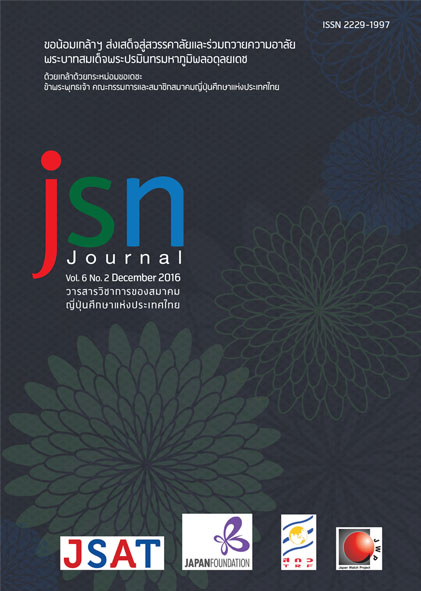A Study of Learning Achievement of Basic Japanese 1 by Using the Flipped Classroom for Non-Japanese Major Students of Chiang Mai University
Main Article Content
Abstract
The purposes of this research were to study the learning achievement of non-Japanese major students taught using the Flipped Classroom approach in the teaching of Basic Japanese 1. The sample consisted of 33 non-Japanese major students that had studied in the first semester and 35 students that had studied in the second semester of academic year 2015. The two classrooms were assigned as the control group and the experimental group. The experimental instrument consisted of lesson plans using the Flipped Classroom method for the experimental group and normal plans for the control group. The data collecting instrument included a learning achievement test and a satisfaction questionnaire on the Flipped Classroom approach. The data were analyzed using statistical methods to find the mean value, the standard deviation, and the t-test score. The result showed that the learning achievement of the students in the experimental group and that of the control group were not significantly different at the .05 level. However, the learning achievement of the students that had no previous study experience with Japanese was significantly higher than that of students that had learned under a conventional instruction method at the .05 level.
Article Details
ข้อความและข้อคิดเห็นต่างๆ ในบทความเป็นของผู้เขียนบทความนั้นๆ ไม่ใช่ความเห็นของกองบรรณาธิการหรือของวารสาร jsn Journal
References
Bergmann, J., & Sams, A. (2012). Flip your classroom: Reach every student in every class every day. Eugene, Or. : International Society for Technology in Education.
The Japan Foundation, Bangkok. 見る!日本語の教え方 Watch! Teaching Japanese Videos.Retrieved from http://miru-oshiekata.blogspot.com/?view=classic
Watanabe, Y. (2014). Flipping a Japanese language classroom: seeing its impact from a student survey and YouTube analytics. In B. Hegarty, J. McDonald, & S.-K. Loke (Eds.), Rhetoric and Reality: Critical perspectives on educational technology. Proceedingsascilite 2014, November 23-26, Dunedin, Newzealand, 761-765.
Yixing, L. (2015). Flipped Classroom Theories of Japanese Teaching. Retrieved fromhttp://www.atlantis-press.com/php/download_paper.php?id=25840762
溝上慎一. (2014).『アクティブラーニングと教授学習パラダイムの転換』.東京,東信堂.
ปางลีลา บูรพาพิชิตภัย. (มปป). The Flipped Classroom กับการจัดการเรียนการสอนในประเทศไทย. Retrieved from https://www.academia.edu/10373765/The_Flipped_Classroom_กับการจัดการเรียนการสอนในประเทศไทย_The_Flipped_Classroom_to_Learning_and _teaching_in_Thailand
วิจารณ์ พานิช. (2557). ครูเพื่อศิษย์สร้างห้องเรียนกลับทาง. กรุงเทพฯ:มูลนิธิสยามกัมมาจล.


